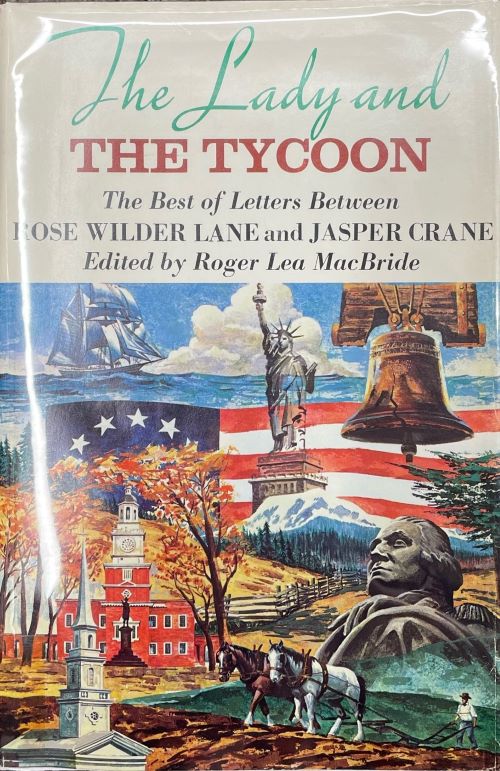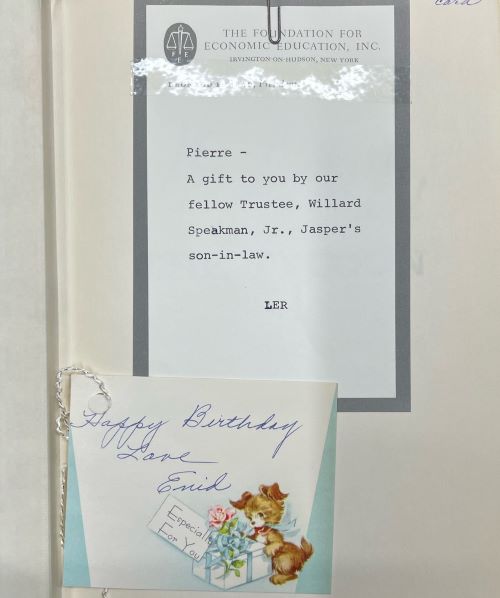The lively colors of this book from Pierre Goodrich's personal collection made it jump off the shelf during this week's visit to the Liberty Fund rare book room. The title is not, as I had first speculated, that of a romance novel. Instead, The Lady and the Tycoon is a collection of letters exchanged between Rose Wilder Lane and Jasper Crane, the Vice President of DuPont.
The Reading Room
The Lady and the Tycoon: From the Liberty Fund Rare Book Room
Lane, who is one of the triumverate of women (along with Ayn Rand and Isabel Paterson) who were crucial to the libertarian movement in mid-century America, There are many discussions of that complex network of relationships, the most recent of which is Tim Sandefur's Freedom's Furies. Less often discussed is the 25 year correspondence between Wilder Lane and Jasper Crane.Anyone with doubts about the themes of this extensive correspondence will rapidly be enlightened by the cover of The Lady and the Tycoon, which seems to have tried to put every possible American icon on the cover at once.

From the ploughman to the white-steepled church to the Liberty Bell and the Mayflower, nothing is left out. Entertainingly, in one of the letters exchanged between Wilder Lane and Crane, she seems to indicate that this kind of iconography would not have pleased her. She writes:

From the ploughman to the white-steepled church to the Liberty Bell and the Mayflower, nothing is left out. Entertainingly, in one of the letters exchanged between Wilder Lane and Crane, she seems to indicate that this kind of iconography would not have pleased her. She writes:
I do not go into rhapsodies about “my country,” its rocks and rills, its super highways and wooded hills, as Bob does in that “Tiger” piece you sent me. This whole world is almost unbearably beautiful; why should I love Oak Creek Canyon or California’s beaches or Washington’s Sea Island counties any more than the Bocca di Cattaro or Delphi or the Bosphorus? Because I, me, the great RWL, was born in the Dakota Territory? The logic seems weak, somehow, don’t you feel?...My attachment to these USA is wholly, entirely, absolutely to The Revolution, the real world revolution, which men began here and which has – so to speak – a foothold on earth here.
For Lane it was the American idea, not the American location that mattered. She and Crane seem to have connected over that set of ideas, and then formed a friendship that included discussion of their gardens, the annual snowfall rate in the Dakotas, their current reading, and just about everything else.
The scope of the correspondence, its origin in ideas, and its free wandering thereafter must have been what suggested the book as a birthday gift for Goodrich. His edition contains two cards--one of which indicates that the book was a gift from a FEE trustee, and one of which indicates it was a gift from his wife, Enid Goodrich. I don't know which was the case, or whether the book was a gift from both at once. But it seems quite clear that people who knew Goodrich well felt the book was exactly his kind of thing.
If it's your, you can find used copies on Amazon here, with the same delightfully vivid cover.

The scope of the correspondence, its origin in ideas, and its free wandering thereafter must have been what suggested the book as a birthday gift for Goodrich. His edition contains two cards--one of which indicates that the book was a gift from a FEE trustee, and one of which indicates it was a gift from his wife, Enid Goodrich. I don't know which was the case, or whether the book was a gift from both at once. But it seems quite clear that people who knew Goodrich well felt the book was exactly his kind of thing.
If it's your, you can find used copies on Amazon here, with the same delightfully vivid cover.
